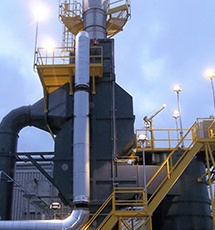Catalytic Products International (CPI) installed a Regenerative Thermal Oxidizer (RTO) at a Southwest midstream natural gas processing facility for the abatement of VOCs such as benzene, toluene, and xylene (BTX) and other compounds from two (2) Amine Hydration treaters.

An amine stripper is a countercurrent stripping process where natural gas is directed into the bottom of a tall tower, and an amine liquid solution is poured into the top of the tower. As the gas contacts the liquid, the CO2, water, and H2S impurities are adsorbed from that gas and held in the fluid. The natural gas is now processed and ready to be directed to the downstream users. The amine system uses a reboiler that boils off the CO2, water, other VOC's, and H2S so the amine solution can be reused. The vent gas from the re-boiler is subject to EPA guidelines: 40 CFR, Part 63, Subpart HH. Under this rule, greater than 95% of the pollutants must be destroyed before release to the atmosphere.
A 10,000 SCFM RTO destroys the incoming VOCs from the combined exhaust streams at a destruction rate efficiency (DRE) of +98% and a thermal efficiency of 95%. The RTO incorporates all the necessary components to exceed air compliance and operational requirements, while also using innovative design features to provide a long lasting, highly reliable system.
A Hot Gas Bypass to the RTO system provides a method of controlling the RTO under high VOC conditions and ensures VOC destruction is maintained without cause for high-temperature shut-down.
In addition to the high concentration of VOCs in the amine tail gas, the process gas stream contains a high concentration of CO2, zero oxygen, and trace amounts of hydrogen sulfide (H2S) which are taken into account with the Materials of Construction (MOC) of the RTO to prevent corrosion.
CPI provided a turnkey installation of the Regenerative Thermal Oxidizer (RTO) including engineering, design, and supply of the RTO on an CPI designed concrete foundation. Rigging and assembly included fresh air/purge air dampers, booster fan, exhaust stack, and a Temperature Safety System (TSS) control and monitoring package. In this application, all components that come in contact with the process gas were constructed using wetted stainless steel to resist corrosion, heat, and thermal cycling.
Thermal treatment of VOCs and other air pollutants works by a simple reaction of the harmful hydrocarbon-based air pollutants with oxygen and heat. In this environment, the VOCs are oxidized to form harmless inert by-products like CO2, water vapor (H2O), and usable heat. These harmless by-products are released to the atmosphere or used within primary or secondary energy recovery techniques to further lower the operational costs.
CPI Regenerative Thermal Oxidizers (RTOs) are engineered to provide exceptional performance and reliability. During operation of the standard two chamber RTO, the VOCs are directed into one of the system’s regenerators, an internally insulated vessel containing specialized ceramic media which allows thermal rate efficiencies up to 97%. The contaminated gases are passed through the first regenerator where energy is transferred from the ceramic media to the gas in order to elevate the temperature. This elevated temperature approaches the ignition level for most solvents and is then directed from the ceramic bed into the combustion chamber. As the stream exits the ceramic bed and travels through the internally lined combustion chamber, minimal heat is added to ensure a proper oxidation temperature and a designed dwell time is maintained providing destruction of the VOCS at greater than 98% efficiency. The resultant clean, oxidized gases are directed to the second regenerator to absorb the heat energy before being released to the atmosphere.
Since 1969, CPI has been Enabling Clean Production™ as a leading supplier of air pollution control solutions. CPI is at the forefront in providing industries including oil and gas processing companies with solutions to their air pollution control needs.
Today, CPI partners with its customers as a trusted resource in resolving the most complex air pollution and energy conservation problems. We provide our customers with innovative and cost-conscious solutions to their most complex VOC, NOx, and Odor pollution challenges. Our equipment is also at work meeting energy conservation strategies and minimizing greenhouse gas (GHG) emissions.








